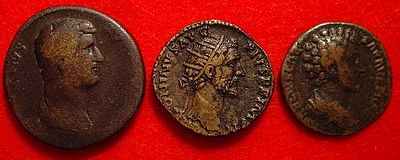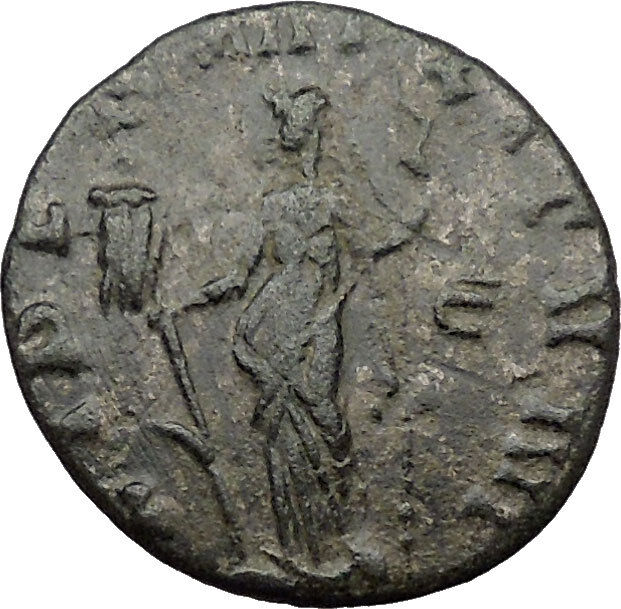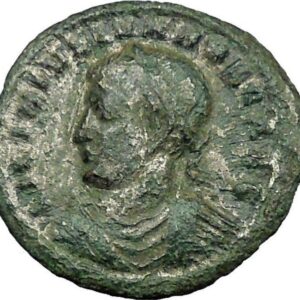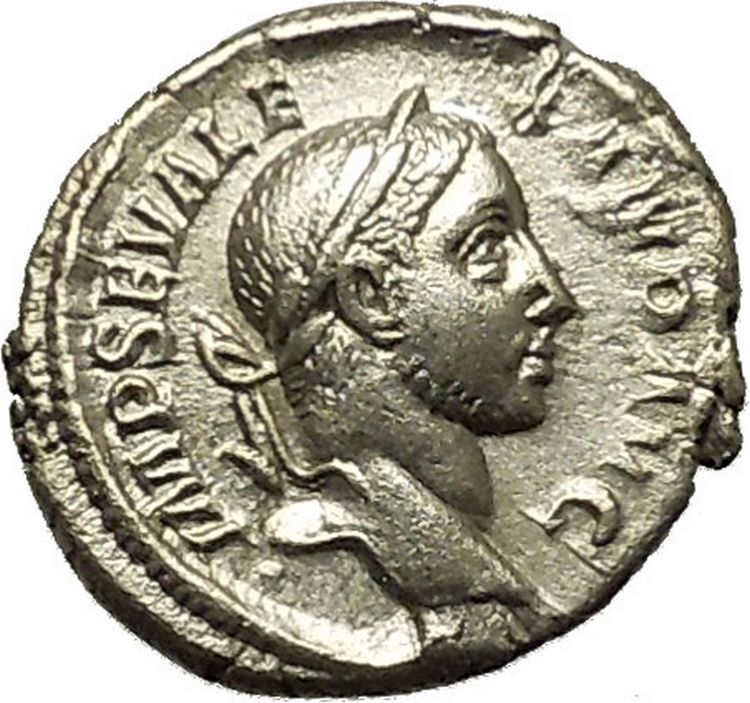|
Antoninus Pius
–
Roman Emperor
: 138-161 A.D.
Marcus Aurelius father
Bronze
Sestertius
30mm (18.09 grams) Rome mint: 154-155 A.D.
Reference: RIC 929, BMC 1963, C 543
ANTONINVSAVGPIVSPPIMPII – Laureate head right.
LIBERTASCOSIIII –
Libertas
standing left,
holding pileus and scepter; S C across fields.
You are bidding on the exact
item pictured, provided with a Certificate of Authenticity and Lifetime
Guarantee of Authenticity.
LIBERTAS – Liberty is represented in two ways on coins: the one as a
woman with a naked head, which is the image of Roman Liberty; the other having
her head covered with a veil, and adorned with a diadem, is the effigy of the
goddess of liberty, whose temple was on Mount Aventine. The veil is in this case
the token of divinity, as indeed the diadem is the ornament of a goddess.
Liberty is represented not only on consular medals, but also with considerable
frequency on those of the imperial series.
Goddesses named for and representing the concept Liberty have existed
in many cultures, including classical examples dating from the
Roman Empire
and some national symbols such as
the British
“Britannia”
or the Irish
“Kathleen
Ni Houlihan“. The
ancient Roman
goddess
Libertas
was honored during the
second Punic War
by a temple erected on the
Aventine Hill
in
Rome by the father of
Tiberius Gracchus
. A statue in her honor was
also raised by Clodius
on the site of
Marcus Tullius Cicero
‘s house after it had been
razed. The figure also resembles Sol Invictus, the Roman god of sun.
The sestertius, or sesterce, (pl. sestertii) was an
ancient Roman
coin. During the
Roman Republic
it was a small,
silver
coin issued only on rare occasions.
During the
Roman Empire
it was a large
brass
coin.

Helmed Roma head right, IIS behind
Dioscuri
riding right, ROMA in linear frame
below. RSC4, C44/7, BMC13.
The name sestertius (originally semis-tertius) means “2 ½”, the
coin’s original value in
asses
, and is a combination of semis
“half” and tertius “third”, that is, “the third half” (0 ½ being the
first half and 1 ½ the second half) or “half the third” (two units
plus half the third unit, or halfway between the second unit and
the third). Parallel constructions exist in
Danish
with halvanden (1 ½),
halvtredje (2 ½) and halvfjerde (3 ½). The form sesterce,
derived from
French
, was once used in preference to the
Latin form, but is now considered old-fashioned.
It is abbreviated as (originally IIS).

Example of a detailed portrait of
Hadrian
117 to 138
History
The sestertius was introduced c. 211 BC as a small
silver
coin valued at one-quarter of a
denarius
(and thus one hundredth of an
aureus
). A silver denarius was supposed to
weigh about 4.5 grams, valued at ten grams, with the silver sestertius valued at
two and one-half grams. In practice, the coins were usually underweight.
When the denarius was retariffed to sixteen asses (due to the gradual
reduction in the size of bronze denominations), the sestertius was accordingly
revalued to four asses, still equal to one quarter of a denarius. It was
produced sporadically, far less often than the denarius, through 44 BC.

Hostilian
under
Trajan Decius
250 AD
In or about 23 BC, with the coinage reform of
Augustus
, the denomination of sestertius was
introduced as the large brass denomination. Augustus tariffed the value of the
sestertius as 1/100 Aureus
. The sestertius was produced as the
largest brass
denomination until the late 3rd century
AD. Most were struck in the mint of
Rome but from AD 64 during the reign of
Nero (AD 54–68) and
Vespasian
(AD 69–79), the mint of
Lyon (Lugdunum), supplemented production. Lyon sestertii can
be recognised by a small globe, or legend stop), beneath the bust.[citation
needed]
The brass sestertius typically weighs in the region of 25 to 28 grammes, is
around 32–34 mm in diameter and about 4 mm thick. The distinction between
bronze
and brass was important to the Romans.
Their name for brass
was
orichalcum
, a word sometimes also spelled
aurichalcum (echoing the word for a gold coin, aureus), meaning
‘gold-copper’, because of its shiny, gold-like appearance when the coins were
newly struck (see, for example
Pliny the Elder
in his Natural History
Book 34.4).
Orichalcum
was considered, by weight, to be
worth about double that of bronze. This is why the half-sestertius, the
dupondius
, was around the same size and weight
as the bronze as, but was worth two asses.
Sestertii continued to be struck until the late 3rd century, although there
was a marked deterioration in the quality of the metal used and the striking
even though portraiture remained strong. Later emperors increasingly relied on
melting down older sestertii, a process which led to the zinc component being
gradually lost as it burned off in the high temperatures needed to melt copper (Zinc
melts at 419 °C, Copper
at 1085 °C). The shortfall was made up
with bronze and even lead. Later sestertii tend to be darker in appearance as a
result and are made from more crudely prepared blanks (see the
Hostilian
coin on this page).
The gradual impact of
inflation
caused by
debasement
of the silver currency meant that
the purchasing power of the sestertius and smaller denominations like the
dupondius and as was steadily reduced. In the 1st century AD, everyday small
change was dominated by the dupondius and as, but in the 2nd century, as
inflation bit, the sestertius became the dominant small change. In the 3rd
century silver coinage contained less and less silver, and more and more copper
or bronze. By the 260s and 270s the main unit was the double-denarius, the
antoninianus
, but by then these small coins
were almost all bronze. Although these coins were theoretically worth eight
sestertii, the average sestertius was worth far more in plain terms of the metal
they contained.
Some of the last sestertii were struck by
Aurelian
(270–275 AD). During the end of its
issue, when sestertii were reduced in size and quality, the
double sestertius
was issued first by
Trajan Decius
(249–251 AD) and later in large
quantity by the ruler of a breakaway regime in the West called
Postumus
(259–268 AD), who often used worn old
sestertii to
overstrike
his image and legends on. The double
sestertius was distinguished from the sestertius by the
radiate crown
worn by the emperor, a device
used to distinguish the dupondius from the as and the antoninianus from the
denarius.
Eventually, the inevitable happened. Many sestertii were withdrawn by the
state and by forgers, to melt down to make the debased antoninianus, which made
inflation worse. In the coinage reforms of the 4th century, the sestertius
played no part and passed into history.

Sestertius of
Hadrian
, dupondius of
Antoninus Pius
, and as of
Marcus Aurelius
As a unit of account
The sestertius was also used as a standard unit of account, represented on
inscriptions with the monogram HS. Large values were recorded in terms of
sestertium milia, thousands of sestertii, with the milia often
omitted and implied. The hyper-wealthy general and politician of the late Roman
Republic,
Crassus
(who fought in the war to defeat
Spartacus
), was said by Pliny the Elder to have
had ‘estates worth 200 million sesterces’.
A loaf of bread cost roughly half a sestertius, and a
sextarius
(~0.5 liter) of
wine anywhere from less than half to more than 1 sestertius. One
modius
(6.67 kg) of
wheat
in 79 AD
Pompeii
cost 7 sestertii, of
rye
3 sestertii, a bucket 2 sestertii, a tunic 15 sestertii, a donkey 500 sestertii.
Records from Pompeii
show a
slave
being sold at auction for 6,252
sestertii. A writing tablet from
Londinium
(Roman
London
), dated to c. 75–125 AD, records the
sale of a Gallic
slave girl called Fortunata for 600
denarii, equal to 2,400 sestertii, to a man called Vegetus. It is difficult to
make any comparisons with modern coinage or prices, but for most of the 1st
century AD the ordinary
legionary
was paid 900 sestertii per annum,
rising to 1,200 under
Domitian
(81-96 AD), the equivalent of 3.3
sestertii per day. Half of this was deducted for living costs, leaving the
soldier (if he was lucky enough actually to get paid) with about 1.65 sestertii
per day.
Perhaps a more useful comparison is a modern salary: in 2010 a private
soldier in the US Army (grade E-2) earned about $20,000 a year.
Numismatic value

A sestertius of
Nero
, struck at
Rome
in 64 AD. The reverse depicts
the emperor on horseback with a companion. The legend reads DECVRSIO,
‘a military exercise’. Diameter 35mm
Sestertii are highly valued by
numismatists
, since their large size gave
caelatores (engravers) a large area in which to produce detailed portraits
and reverse types. The most celebrated are those produced for
Nero (54-68 AD) between the years 64 and 68 AD, created by some of
the most accomplished coin engravers in history. The brutally realistic
portraits of this emperor, and the elegant reverse designs, greatly impressed
and influenced the artists of the
Renaissance
. The series issued by
Hadrian
(117-138 AD), recording his travels
around the Roman Empire, brilliantly depicts the Empire at its height, and
included the first representation on a coin of the figure of
Britannia
; it was revived by
Charles II
, and was a feature of
United Kingdom
coinage until the
2008 redesign
.
Very high quality examples can sell for over a million
dollars
at auction as of 2008, but the coins
were produced in such colossal abundance that millions survive. Worn, but
recognisable, examples of common types can be found for as little as £10 or $20.
Titus Aurelius Fulvus Boionius Arrius Antoninus (19 September 86 – 7
March 161), generally known in English as Antoninus Pius was
Roman emperor
from 138 to 161. He was the fourth of the
Five Good Emperors
 and a member of the and a member of the
Aurelii
. He
did not possess the
sobriquet
“Pius” until after
his accession to the throne. Almost certainly, he earned the name “Pius” because
he compelled the
Senate
to deify his adoptive father
Hadrian
; the
Historia Augusta
, however, suggests that he may have earned the name by
saving senators sentenced to death by Hadrian in his later years.
//
He was the son and only child of
Titus Aurelius Fulvus
,
consul
in 89
whose family came from
Nemausus
(modern Nîmes
)
and was born near
Lanuvium
and his mother was Arria Fadilla. Antoninus’ father and paternal grandfather
died when he was young and he was raised by
Gnaeus Arrius Antoninus
, his maternal grandfather, a man of integrity and
culture and a friend of
Pliny the Younger
. His mother married to Publius Julius Lupus (a man of
consular rank),
Suffect
Consul
in 98, and bore him a daughter called Julia Fadilla.
As a private citizen between 110 and 115, he married Annia Galeria
Faustina the Elder
. They had a very happy marriage. She was the daughter of
consul
Marcus Annius Verus
and
Rupilia
Faustina (a half-sister to Roman Empress
Vibia
Sabina
). Faustina was a beautiful woman, renowned for her wisdom. She spent
her whole life caring for the poor and assisting the most disadvantaged Romans.
Having filled with more than usual success the offices of
quaestor
and praetor
,
he obtained the consulship in 120; he was next appointed by the Emperor
Hadrian
as
one of the four
proconsuls
to administer
Italia
, then greatly increased his reputation by his conduct as
proconsul
of
Asia
. He acquired much favor with the Emperor Hadrian, who adopted him as
his son and successor on 25 February, 138, after the death of his first adopted
son Lucius Aelius
, on the condition that Antoninus would in turn adopt Marcus
Annius Verus, the son of his wife’s brother, and Lucius, son of Aelius Verus,
who afterwards became the emperors
Marcus Aurelius
and
Lucius
Verus
(colleague of Marcus Aurelius).
Emperor
On his accession, Antoninus’ name became “Imperator Caesar Titus Aelius
Hadrianus Antoninus Augustus Pontifex Maximus”. One of his first acts as Emperor
was to persuade the
Senate
to grant divine honours to Hadrian, which they had at first refused; his efforts
to persuade the Senate to grant these honours is the most likely reason given
for his title of Pius (dutiful in affection; compare
pietas
). Two other reasons for this title are that he would support his
aged father-in-law with his hand at Senate meetings, and that he had saved those
men that Hadrian, during his period of ill-health, had condemned to death. He
built temples, theaters, and mausoleums, promoted the arts and sciences, and
bestowed honours and financial rewards upon the teachers of
rhetoric
and philosophy
.
In marked contrast to his predecessors
Trajan
and
Hadrian
,
Antoninus was not a military man. One modern scholar has written “It is almost
certain not only that at no time in his life did he ever see, let alone command,
a Roman army, but that, throughout the twenty-three years of his reign, he never
went within five hundred miles of a legion”.[2]
His reign was the most peaceful in the entire history of the
Principate
;
while there were several military disturbances throughout the Empire in his
time, in Mauretania
,
Iudaea
, and amongst the
Brigantes
in Britannia
, none of them are considered serious. The unrest in Britannia is
believed to have led to the construction of the
Antonine Wall
from the
Firth of Forth
to the
Firth of Clyde
, although it was soon abandoned. He was virtually unique
among emperors in that he dealt with these crises without leaving Italy once
during his reign, but instead dealt with provincial matters of war and peace
through their governors or through imperial letters to the cities such as
Ephesus (of which some were publicly displayed). This style of government was
highly praised by his contemporaries and by later generations.
Of the public transactions of this period we have scant information, but, to
judge by what we possess, those twenty-two years were not remarkably eventful in
comparison to those before and after his; the surviving evidence is not complete
enough to determine whether we should interpret, with older scholars, that he
wisely curtailed the activities of the Roman Empire to a careful minimum, or
perhaps that he was uninterested in events away from Rome and
Italy
and his
inaction contributed to the pressing troubles that faced not only Marcus
Aurelius but also the emperors of the third century. German historian Ernst
Kornemann has had it in his Römische Geschichte [2 vols., ed. by H. Bengtson,
Stuttgart 1954] that the reign of Antoninus comprised “a succession of grossly
wasted opportunities,” given the upheavals that were to come. There is more to
this argument, given that the Parthians in the East were themselves soon to make
no small amount of mischief after Antoninus’ passing. Kornemann’s brief is that
Antoninus might have waged preventive wars to head off these outsiders.
Scholars place Antoninus Pius as the leading candidate for fulfilling the
role as a friend of Rabbi
Judah
the Prince
. According to the
Talmud
(Avodah
Zarah 10a-b), Rabbi Judah was very wealthy and greatly revered in Rome. He had a
close friendship with “Antoninus”, possibly Antoninus Pius,
who would consult Rabbi Judah on various worldly and spiritual matters.
After the longest reign since Augustus (surpassing
Tiberius
by
a couple of months), Antoninus died of fever at
Lorium
in
Etruria
,
about twelve miles (19 km) from Rome, on 7 March 161, giving the keynote to his
life in the last word that he uttered when the
tribune
of
the night-watch came to ask the password—”aequanimitas” (equanimity). His body
was placed in
Hadrian’s mausoleum
, a
column
was dedicated to him on the
Campus Martius
, and the
temple
he had built in the Forum in 141 to his deified wife Faustina was
rededicated to the deified Faustina and the deified Antoninus.
Historiography
The only account of his life handed down to us is that of the
Augustan History
, an unreliable and mostly fabricated work. Antoninus is
unique among Roman emperors in that he has no other biographies. Historians have
therefore turned to public records for what details we know.
In
later scholarship
Antoninus in many ways was the ideal of the landed gentleman praised not only
by ancient Romans, but also by later scholars of classical history, such as
Edward Gibbon
or the author of the article on Antoninus Pius in the ninth
edition of the
Encyclopedia Britannicaca:
A few months afterwards, on Hadrian’s death, he was enthusiastically
welcomed to the throne by the Roman people, who, for once, were not
disappointed in their anticipation of a happy reign. For Antoninus came
to his new office with simple tastes, kindly disposition, extensive
experience, a well-trained intelligence and the sincerest desire for the
welfare of his subjects. Instead of plundering to support his
prodigality, he emptied his private treasury to assist distressed
provinces and cities, and everywhere exercised rigid economy (hence the
nickname κυμινοπριστης “cummin-splitter”). Instead of exaggerating into
treason whatever was susceptible of unfavorable interpretation, he
spurned the very conspiracies that were formed against him into
opportunities for demonstrating his clemency. Instead of stirring up
persecution against the Christians, he extended to them the strong hand
of his protection throughout the empire. Rather than give occasion to
that oppression which he regarded as inseparable from an emperor’s
progress through his dominions, he was content to spend all the years of
his reign in Rome, or its neighborhood.
|










 and a member of the
and a member of the


